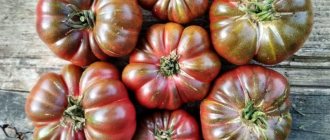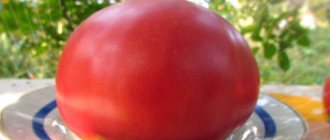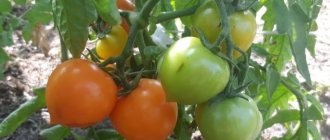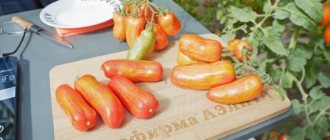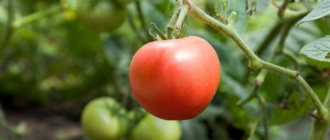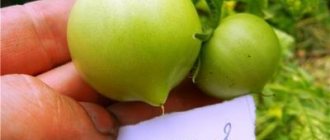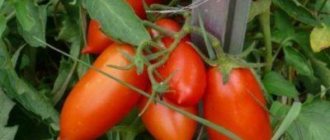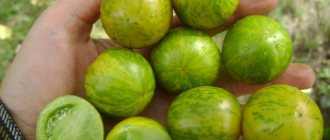Once you have seen such a miracle as the Apricot tomato, it is difficult to pass by. The bushes bring a rich harvest and are unpretentious in care; they are suitable for different climatic conditions. The fruits are distinguished by high taste and beneficial qualities.
| Height | Landing location | Ripening time | Fruit color | Fruit size | Origin | Fruit shape |
| Medium height | Greenhouse, Open ground | Early ripening | Yellow | Small | Hybrid | Round |
Description
Hybrid tomato can be cultivated in different conditions depending on the region:
- in the south of the country - right in the garden;
- in the middle zone - under the film (in greenhouses);
- in colder areas - in winter greenhouses.
This is due to the fact that during the growing season temperature changes, which are often found in the central European part and more northern latitudes, are extremely undesirable for this crop.
The ripening period for tomatoes is 100–105 days. They have fleshy flesh, a sugary structure and a sweet taste with a slight sourness. Excellent appearance, excellent shelf life and safety during transportation, as well as other commercial qualities have made the Apricot hybrid in demand among farmers who grow large quantities of vegetables for sale. In addition, the planted bushes do not require special care and are very unpretentious in terms of environmental conditions.
Related article:
How to grow tomatoes in a greenhouse
What do summer residents say about the Apricot hybrid?
Reviews from vegetable growers contain a lot of useful information for a novice gardener. In addition to their opinion about the species, they find tips and solutions to problems that arise during cultivation.
Diana: “I bought it on the advice of a friend. The whole family really liked the juicy and sweet fruits. Another advantage is the early ripening of tomatoes and high yield.”
Elena: “I accidentally noticed a pack of seeds on the counter and decided to experiment. I don’t regret it, the fruits are very tasty and juicy. There were no particular difficulties during cultivation. I used tomatoes for canning and making fresh salads.”
Apricot tomatoes are sure to please everyone who is patient in caring for them.
Main characteristics
As a hybrid plant, Apricot has the following characteristics:
- indeterminate, tall (140–180cm);
- standard, compact (not spreading)
- shoots and leaves are bluish-green.
The fruits are characterized by the following properties:
- round form;
- large size and average weight in the range of 350–500 g;
- dense juicy pulp with sugar content at the break;
- 4 or 5 seed chambers;
- 5–6% dry matter.
On tomatoes that have just set, whitish hairs are clearly visible. Over time, they become less noticeable, but a small fluff on the skin remains. Fully ripened fruits have a light or deep pink color.
Tomato "Apricot" F1: description of the variety
Tomato “Apricot” F1 is a mid-season hybrid; from planting seedlings to the ripening of the first fruits you will have to wait 105-110 days. The plant is indeterminate, standard, quite tall, 140-180 cm.
This type of tomato is recommended for growing in greenhouses and in open ground . It is highly resistant to fruit cracking and tobacco mosaic, as well as other types of diseases.
Ripe fruits are pink or dark pink in color, they are dense and fleshy. Round in shape. In accordance with the description of tomato varieties, the Apricot tomato has the largest fruits among the pubescent representatives; the weight of the fruit varies from 350 to 500 grams.
Number of chambers 4-5, dry matter content 5-6%. The collected fruits can be stored for a long time and tolerate transportation well. For these commercial qualities, it was loved by farmers who grow tomatoes for sale in large volumes.
You can compare the weight of fruits with other varieties below:
| Variety name | Fruit weight |
| Apricot | 350-500 grams |
| Mystery | 75-110 grams |
| Big Mama | 200-400 grams |
| Banana legs | 60-110 grams |
| Petrusha the gardener | 180-200 grams |
| Honey saved | 200-600 grams |
| Beauty King | 280-320 grams |
| Pudovik | 700-800 grams |
| Persimmon | 350-400 grams |
| Nikola | 80-200 grams |
| Right size | 300-800 |
Read more about diseases of tomatoes in greenhouses in the articles on our website, as well as about methods and measures to combat them. You will also be able to get acquainted with information about high-yielding and disease-resistant varieties, about tomatoes that are not at all susceptible to late blight.
Varieties
The “apricot” group of tomatoes is represented by two more varieties:
- Summer apricot is mid-season, grown in open and closed ground, semi-determinate (grows up to 150–160 cm). Needs shaping - to increase productivity it is necessary to leave 2-3 shoots on the bush. The fruits are orange in color, round-flat and very large (average weight 400–800 g, and some specimens reach a weight of 1 kg). The pulp is juicy, with a delicate taste. Not many seeds.
- Yellow apricot is early ripening, cultivated in open and closed ground, determinate (height is no more than 40 cm). Requires support and molding with removal of part of the shoots. The fruits are round, yellow, small (average weight 50–80 g). It is characterized by abundant fruiting, during which the bushes are completely covered with bunches of tomatoes. The variety is resistant to nightshade diseases.
Related article:
Growing tomato seedlings at home
Summer apricot
Apricot yellow
Productivity
The Apricot hybrid stands out among all other types of pubescent tomatoes due to its largest fruits. Their weight can reach 500 g, therefore, under good weather conditions and proper agricultural practices, at least 3.5–5 kg of crop is usually harvested from one bush. Since the recommended planting density is 4 bushes per 1 sq. m, then from this area you can collect at least 18–20 kg, which is considered a very high yield.
Yellow Apricot is characterized by ultra-fast ripening and also an abundant harvest. But its yield is slightly lower than that of the pink pubescent tomato, since the fruits themselves are much smaller (up to 80 g each). Therefore, with proper care and suitable weather, from 1 sq. m you can collect 12–15 kg of yellow tomatoes.
Area of application of fruits
The large and dense fruits of the Apricot hybrid are ideal for salads, slices, sandwiches, burgers and other snacks. They are also used for making juice, sauce, tomato paste and barrel pickles. Due to their large size, these tomatoes are not used only in whole-fruit canning.
Small, sweet and juicy yellow tomatoes of the Summer Apricot variety with thick, non-cracking skin have a wider range of uses. Along with preparing various snacks, dishes and preparations, they can be preserved entirely.
Reviews about the variety from those who planted
The harvested crop can be stored for a long time and tolerates transportation well. Thanks to these commercial qualities, the Apricot hybrid is popular among farmers who grow tomato crops for sale in large quantities.
The presence of many advantages, with virtually no disadvantages, allows the Apricot hybrid to quickly gain popularity among gardeners.
Growing the Apricot hybrid will not cause any trouble for gardeners, since it is unpretentious in care. By following simple care recommendations, you are guaranteed to get an excellent harvest of fluffy tomatoes.
Diseases and pests
The “Apricot” series of tomatoes is resistant to fungi and viruses that cause diseases of nightshade crops. But if the soil on the site is contaminated or diseased plants grow nearby, the hybrid may be affected by certain infections, the active spread of which is facilitated by wind, heat and humidity.
The most common:
- Late blight. When the first signs appear, the plants should be treated with Barrier. At the deep stage, the stronger drug Zaslon is used.
- Fomoz. Diseased tomatoes are removed from the garden, and the rest are treated with the fungicide Hom.
Among the pests that can attack Apricot tomatoes:
- nightshade miner;
- rusty tick.
In both cases, the insecticidal preparation Zubr is used.
Variety criteria
Having studied the description of the variety, it is easier to grow the crop on the site, since there is no chance of making a mistake. By choosing the right place and carrying out competent care, you get the declared tomato harvest.
Plant:
- Standard.
- Determinant type.
- Compact.
- A very early variety, ripens in 80-90 days.
Tomatoes:
- Round shape.
- Yellow color.
- Weighing 80-100 g.
- They taste sweet.
- Density is average.
- Excellent storage.
- Can withstand long-term transportation.
The presence of positive characteristics, in the absence of disadvantages, allows the variety to quickly gain popularity and recognition among summer residents.
Advantages and disadvantages
The main advantages of the hybrid include the following properties:
- excellent taste;
- high productivity;
- duration of fruiting;
- resistance to fruit cracking;
- early ripeness (simultaneous ripening both in the beds and in greenhouse conditions);
- hypoallergenic (can be used if you are allergic to other tomatoes).
The disadvantage is the weakness of the stems and branches, which, without being tied to a support, easily break off under the weight of the fruit.
Planting and care
To propagate hybrid tomatoes, the seedling method is used. The period of growing seedlings is 55–60 days from the moment of sowing the seeds, after which they can be transplanted to a permanent place.
The sowing and care algorithm should be as follows:
- seedling containers are disinfected, a drainage layer of fine charcoal is poured onto the bottom, then a soil mixture or soil is added;
- the seed is soaked for 2 hours in a solution of Kornevin, Kornerost or another stimulating drug, then the liquid is drained and slightly dried;
- sow to a depth of 1 cm, water with slightly warmed water by spraying;
- cover with a glass lid or film and leave until sprouts appear;
- then the cover is removed and the soil is periodically sprayed with water, preventing it from drying out.
When the first pair of true leaves begins to form on the sprouts, the seedlings are planted in separate containers. Peat cups are best suited for this, in which seedlings can be planted in a permanent place. The planting process is performed in the following order:
- a little crushed coal is poured onto the bottom to ensure drainage, and a mineral complex based on phosphorus, potassium and boron is placed on it;
- the cup is filled to a third of its height with soil mixture, a seedling is planted and then soil is added;
- watered with a solution of calcium nitrate;
- place the cups on pallets and provide about 15 hours of daylight using phytolamps or fluorescent lamps;
- throughout the entire growing period, mineral complexes are added according to the instructions;
- during the last week before transplanting to a permanent place, the seedlings are hardened - taken outside or into a greenhouse, gradually increasing the residence time;
- Stop watering 2-3 days before.
The seedlings are planted in prepared holes arranged according to a 40x40cm pattern. Compost and wood ash are first added to each, and immediately before planting, they are filled with warm water. If the seedlings are planted in peat cups, then they are simply dug in.
Saplings with an open root system are placed in holes at an angle of 45º with their roots facing south so that the top is located slightly higher. Cover the root system with soil and compact it gently but thoroughly, preventing the formation of air space. Water with a solution of calcium nitrate (1 tablespoon per 10 liters of warm water). Sprinkle with dry soil and mulch with straw or sawdust.
Aftercare consists of the following activities:
- timely watering (the best option is to use a drip system that provides moisture directly to the root);
- loosening the soil after each moistening (rain or watering) with simultaneous hilling of the bushes;
- adding organic matter or mineral complexes - 3 times per season (2 weeks after planting, then during budding and during fruiting);
- regular removal of stepsons, fixation on a support.
By strictly following all the rules of agricultural technology, you can prevent the development of diseases and guarantee a rich harvest.
Important! Why do seedlings rot and what to do?
Growing seedlings
Although the Apricot hybrid is early, it is still recommended to grow it in seedlings, this will significantly reduce the waiting period for the fruit to ripen. Seeds are sown 2 months before transferring to a permanent place. The gardener calculates the period himself, taking into account the climate of the growing region.
Requirements for growing high-quality seedling material:
- Lighting. At least 14-16 hours a day; if there is a lack of sunlight, it is recommended to install special lighting devices.
- Temperature. In the room where the containers with seedlings are located, it should be +20-22 ⁰С.
- Watering. In moderation, do not overfill and do not let it dry out.
- Feeding. In order for tomatoes to gain strength, fertilizing with growth stimulants or complex fertilizers is required.
Following these simple rules will help you grow strong seedlings that will produce the desired harvest in the future.
